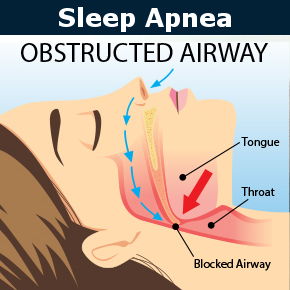Sleep Apnea Burbank

Sleep apnea is the cessation of breathing during sleep. It is a common problem that affects adults and children. Certain types of sleep apnea can be cured by our dentist. Leaving sleep apnea untreated will affect your health.
Without the right diagnosis and proper treatment, sleep apnea can lead to problems such as concentration issues, fatigue, high blood pressure, weight fluctuations, and heart conditions. If you have been diagnosed with sleep apnea or think you might have it, call 1-818-578-2332 for an appointment now. Dr. Sahakyan at My Dentist Burbank will conduct a quick examination with subsequent treatment if necessary.
What Is Sleep Apnea?

Sleep apnea is when you partially stop breathing while asleep, which can repeat and last for ten seconds. Sleep apnea is found not only in adults and the elderly but also in children and adolescents. Approximately 7 to 15% of children of different ages snore in their sleep, which is often accompanied by apnea.
The most common causes of sleep apnea are:
- obstruction (blockage) of the respiratory tract at the pharynx, associated with an increase in the supra-oropharyngeal tongue or the tongue-lingering;
- incorrect location of the lower jaw and other bite abnormalities;
disorders of the central nervous system. - Sleep apnea of obstructive etiology develops in children older than one year. It is a consequence of birth trauma, hereditary pathology, or congenital anomalies.
Symptoms Of Sleep Apnea
The two most common symptoms of sleep apnea are:
- Heavy breathing or suffocation during sleep;
- Loud snoring.
The inability to breathe properly is often manifested in unexpected awakenings at night. It interrupts your sleep and does not allow you to feel refreshed throughout the day. As a result, you may be trying not to fall asleep during the day or feel irritable or depressed.
Common Signs And Symptoms Of Sleep Apnea

- Painful and unexplained headaches in the morning;
- Awakening with a sore throat and dry mouth;
- Memory problems and difficulty concentrating;
- Periodic respiratory arrest during sleep with an intensity of more than 10 seconds 10 times per hour;
- Stopping breathing and moments of silence during snoring followed by a loud and sharp snoring;
- Restless sleep and frequent awakenings;
- The feeling of lack of oxygen, suffocation with periodic awakenings during sleep;
- Urinary incontinence;
- Frequent urination at night;
- The high physical activity of the body during sleep;
- Severe drowsiness during the day;
- Hypertension;
- Feeling tired even after a long sleep.
If one or more symptoms are found, it is recommended that you immediately contact us for diagnostics and advice from an experienced specialist.
Why Does Respiratory Arrest Occur?
During sleep, the musculature of our body, including the soft palate and pharynx, relaxes. The root of the tongue sinks and blocks the airways. However, the diaphragm (the muscle responsible for breathing) continues to receive signals from the brain that breathing needs to continue and rapidly shrinks. Because of narrowing of the respiratory tract in the back of the throat, breathing stops, and the brain receives an alarm signal. Then it uses emergency awakening mechanisms.
According to statistics, this disease shortens the life of a person for 10-15 years.
Causes of Sleep Apnea

The following problems can cause sleep apnea:
- Excess weight;
- Age (people of any age or gender may develop sleep apnea, but men over the age of 40 are more likely to be at risk). This is due to certain anatomical differences in the structure of the neck and larynx, and the fact that muscles become weaker after 40 years;
- Use of sedative medications that affect the relaxation of muscles and prevent normal breathing;
- Physiological features of the structure and dimensions of the tongue, tonsils, lumen of the respiratory tract, jaw, larynx;
- Smoking and alcohol;
- The period of menopause in women, leading to hormonal changes in the body and affecting the relaxation of muscles;
- Hereditary predisposition;
- Diabetes;
- The curvature of the septum of the nose, chronic rhinitis.
Types of Sleep Apnea

Sleep apnea manifests itself in three forms:
- Obstructive;
- Central;
- Complex.
Obstructive Sleep Apnea: The respiratory arrest syndrome blocks the airway due to genetic abnormalities such as excess tissue on the back of the tongue, throat, or nose;
Central Sleep Apnea: This happens when the brain can not send the right signals to the muscles responsible for breathing;
Complex sleep apnea: Complex apnea syndrome (also called nighttime apnea syndrome) is diagnosed when there are features of both obstructive and central and sleep apnea.
Diagnosis of Nocturnal Sleep Apnea
The dentist will give you a checkup and ask about your sleep. You may need to spend a night in a sleep lab.
Detecting sleep apnea is possible with respiratory monitoring devices that have built-in snoring and air flow sensors, a pulse oximetry sensor, and diaphragm functioning sensors. Some instruments allow an Electrocardiogram (ECG) to be used to determine cardiac rhythms during periods of respiratory arrest.
You will wear monitors to check things such as:
- Blood oxygen levels
- Airflow
- Eye movements
- Breathing patterns
- Electrical activity of the brain
- Muscle activity
- Heart rate.
Why Do We Need Polysomnography?

To determine if you have sleep apnea, polysomnography is also widely used, which makes it possible to establish restless leg syndrome or other physical problems during sleep that are characteristic of sleep apnea.
Polysomnography is carried out in the sleep laboratory, where the dentist performs and records several assessments at once:
- Electromyography
- Electrocardiogram (ECG)
- Electroencephalogram (EEG)
- Measurement of the degree of saturation of tissues with oxygen (saturation).
- Electrooculography (Eye movement recording during sleep)
You can check the quality of sleep, the existence of apnea, how much the oxygen tissues get, and how often it occurs.
Our dental office uses modern portable devices that help diagnose the disease with great accuracy and determines the apnea already at the early stages of its manifestation. If you are trying to get relief, your first step will be to meet with Dr. Sahakyan. He will answer your questions about sleep apnea and treatment options.
Treatment of Sleep Apnea
Possible options include:
- Weight loss, if needed.
- Avoiding alcohol in the evening.
- No active exercise before going to sleep.
- Sleeping on your side.
Oral Devices: For the treatment of sleep apnea, our dental office uses special devices for the oral cavity, which treat snoring at the initial and middle stages of the disease. Using snore guards or oral appliances can help supply air to your lungs and stop the vibrating motions that cause snoring. These appliances are comfortable to wear and can be effective for a whole night.
CPAP mach ine: The CPAP (Continuous Positive Airway Pressure) machine ensures a constant movement of air into your lungs. You can enjoy a restful night of sleep without disturbing your partner.
ine: The CPAP (Continuous Positive Airway Pressure) machine ensures a constant movement of air into your lungs. You can enjoy a restful night of sleep without disturbing your partner.
Surgery: Surgery is for people who have misshapen or extra tissue that blocks airflow through the throat or nose.
Treatments may include Oral Appliance Therapy, which has been recommended by the American Academy of Sleep Medicine and the National Institutes. Dr. Sahakyan at My Dentist Burbank will help improve the quality and duration of your life, get rid of apnea, and reduce the risk of consequences.
Even if you just assume that you have possible breathing disorders in your sleep, we recommend that you contact Dr. Sahakyan, the best dentist in Burbank. He will conduct a thorough examination, find out the cause of the Sleep Apnea Burbankcomplications, and prescribe the best treatment. Call 1-818-578-2332 for an appointment today.


